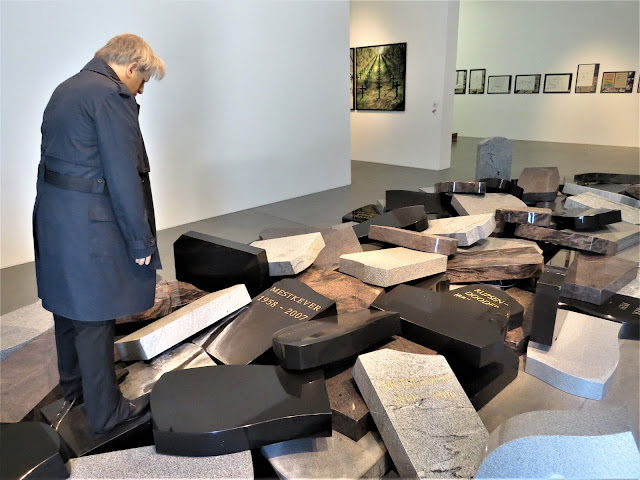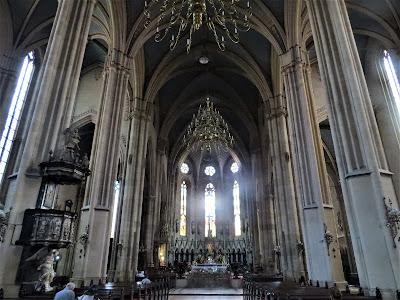 |
| In the old town, everything seems to be in the same direction. Walking in the old town usually involves long flights of stairs and steep hills, but look at all the places you'll go! |
Turns out that it's also home to a large Museum of Contemporary Art, a plaza called Victims of Fascism Square, small but world-class Botanical Gardens, and the wonderful Croatian Museum of Naive Art. At first we thought maybe four nights here were too many, but we had no trouble filling our three full days here.
We arrived by air from Split and a taxi took us to our hotel, Esplanade Zagreb, a rather formal and old-school five-star hotel opened in the 1920s to cater to the wealthy passengers of the Orient Express trains. Only a shady, small square separates it from the train station. After one night in a large room with a view of a giant air shaft, we were relocated for our last three nights to an even larger room with a view of the shady square and the train station.
We spent our days exploring the city. The central part of the city is more or less defined by geography. There is Lower Town, a flat area with many tree-filled squares and palace-like government buildings, an opera house and the Museum of Arts and Crafts on Marshal Tito Square. There was an evening folkloric performance in one of the squares while we were there. Most streets here accommodate cars and often electric streetcars, and form a conventional city grid.
To the north, in the older Upper Town, streets are not so straight, tend to be pedestrian-only, and lead to small museums and restaurants. It took us maybe 15 minutes to walk from our hotel the several blocks to the first hill leading to the old town. Walking here involves a lot of stairs or steep hills. But the payoff is in where your walk ends. A couple of times for us, it ended just north of the pedestrian district at Wine Bar Bornstein, a wine bar and wine shop in a 200-year-old cellar. It has only a small sign on Kaptol Street; you enter by finding your way around to the back of the building and down a steep flight of stairs. On our first visit, we had a well-informed waiter who took time to discuss the wine list with us. On our second visit, that waiter was busy elsewhere and we got the understudy, who seemed barely willing to take our order, which included a much-too-generous platter of meats and cheeses. I'd recommend this place (click HERE) to anyone visiting Zagreb.
Another evening we took a streetcar a few stops west of our hotel to Tian Tan (click HERE), a far-off-the-beaten-track Chinese restaurant on a commercial side street a short walk from a streetcar stop. We almost always have duck at Chinese restaurants, and the duck here was wonderful. Don't expect your hotel to know about this place, though. The Esplanade certainly didn't.
Here are some photos.
 |
| "Gypsy Wedding" (1936, oil on canvas) by Ivan Generalic is among the works by untrained artists at the Croatian Museum of Naive Art. |
 |
| "Luxury Boat" (1974, marker and oil on paper) by Drago Jurak reminded me of works by other untrained artists at the Visionary Arts Museum in Baltimore. |
 |
| This photo is explained below. |
 |
| This bicycle is the subject of a poem, below. |
 |
| This work is little more than its own title. (1993) Mladen Stilinovic, who died in 2016, was one of Croatia's most prominent conceptual artists. |
 |
| Stairs at the Mestrovic Studio in the old town. We were introduced to this prolific artist at his former villa (now a museum) in Split. |
 |
| Everything I saw by Mestrovic was representational, nothing abstract. Many of his works have Croatian themes or subtly promote Croatian national identity. |
 |
| Motherhood figures frequently in his work. |
 |
| Towers of the southern reaches of the Lower Town can be seen in this view to the south, over the red tile roofs of the Upper Town from a high plaza in the Upper Town. |
 |
| Streetcars are easy to use. Just buy tickets at any newsstand. |
 |
| The Zagreb opera house. We didn't get inside, but I bet it's as ornate as the exterior. |
 |
| Zagreb is sometimes described as a gallery of Secessionist architecture. I'm not a student of architecture, but I would guess these buildings, above and below, are examples of that. |
 |
| Dress properly to enter Zagreb's Cathedral of the Assumption of the Blessed Virgin Mary. And don't smoke, be a dog, use a phone, or eat ice cream, either! |
 |
| The cathedral soars above the roofs of the Upper Town. Scaffolding around the right steeple has been there for years as stonemasons repair the damage of years of neglect and air pollution. |
 |
| Wine Bar Bornstein is a great place to sample the many good wines of Croatia. |










No comments:
Post a Comment